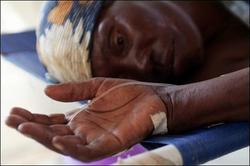 Growing resistance to available tuberculosis (TB) drugs is threatening the world with a new untreatable strain of the deadly disease, experts said at a global lung health conference on Thursday. Growing resistance to available tuberculosis (TB) drugs is threatening the world with a new untreatable strain of the deadly disease, experts said at a global lung health conference on Thursday.
"The danger is real," Mario Raviglione, director of the World Health Organisation`s Stop tuberculosis (TB) department, told AFP on the sidelines of the gathering of some 3,000 health experts in Cape Town.
"Scenarios of an apocalyptic nature are not likely ... but not impossible," said Raviglione.
Raviglione said two or three cases were recently reported in Italy of TB resistant to all currently available drugs. All were fatal.
"There are situations that push us back to the pre-antibiotic era of 1943 ... when there was nothing against tuberculosis except bedrest, and in Europe and North America sanatoria and good nutrition and things like that."
Some two billion people worldwide are infected with TB, about 450,000 of them with a drug resistant strain. About 1.6 million die each year.
A total of 41 countries have reported at least one case of extreme-drug resistant (XDR) TB. This figure may be higher, as many African countries lack laboratories capable of detecting this hard-to-treat strain.
TB drug resistance develops when patients fail to complete their treatment, and can also be directly transmitted from person to person.
Patients with (multi-drug resistant) MDR TB fail to react to the two most powerful and commonly used drugs, while those with XDR TB also showed resistance to at least one of three injectable higher level drugs.
Raviglione said that as long as the treatment remained inadequate and cure rates lower than the required 85 percent, more and more drug resistance would develop.
"If the cure rate of drug resistance remains also low, then the spreading continues," he said.
There was a chance of less than five percent of a completely drug resistant strain becoming dominant, he added.
"However, if you start inputting into the mathematical model a cure rate as low as it is in many countries of Africa today and the XDR epidemic not being addressed with a higher cure rate ... obviously that five percent becomes much more easily reachable."
Raviglione said it was difficult to predict whether new drugs would be developed in time to prevent large-scale resistance, or when.
"You really have to think about a new regimen. We have one (drug) in the pipeline that is already lost -- we must have at least another three or four classes of antibiotics to be safe on this.
"I don`t foresee that anything like that will be available before 2015," he said, adding that XDR TB would in the meantime continue spreading in places like the former Soviet Union and in Africa, hand-in-hand with AIDS.
sections: Nature & Health
|